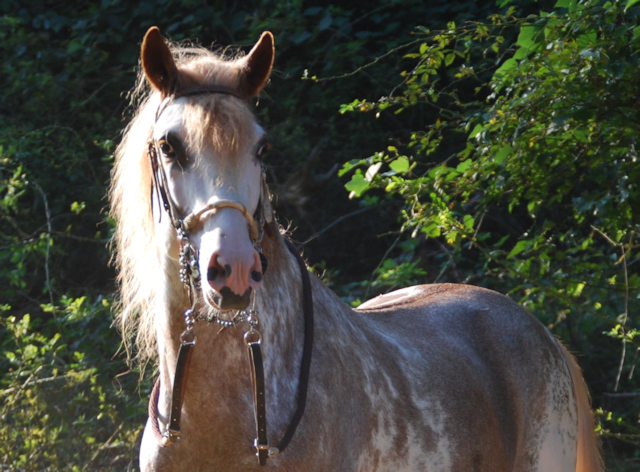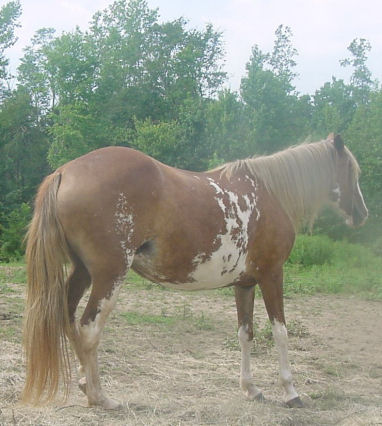Sabino (sah-bee-no)
Sabino is one of the most elusive to breed pinto patterns, partially due to the fact that scientifically
speaking, very little is known about the genetics of sabino patterns.
It was once believed that all sabino patterns were controlled by one gene, expressed in degrees of white and belief
was that a wide variety of markings were possible when mating horses with “chrome”.The recent isolation of the
sb1 gene, and more importantly, the lack of the sb1 gene being present in some breeds that traditionally display
"high white" that were involved in the initial study indicate that there is a series of genes and possibly modifiers that
control patterns and placement of white.
For those that believe sabino to be polygenic, sabino is not merely a matter of the amount of white shown on a horse but in fact the amount of white is indicative of pattern type, and that each pattern or type involves separate genes and/or modifiers – this would explain why some breeds have only one type of sabino pattern (with the very rare exception) and why other breeds may display the full gamut of sabino patterns.
Currently the term sabino includes a wide variety of markings and expressions, however, as of yet, a standard has not been set to describe the patterns.
minimal - "sabino characteristics" all the way to maximum white sabino. Full sabino pintos (with body white patches) are very rare and to date only a very few documented maximum white sabino Paso Fino.
for the purpose of this article I will break the pattern into four basic subtypes.
- Sabino characteristics – tall jagged stockings, chin spot larger blaze (no matter the size or number of these items on one horse)
- Moderate sabino – White blotches of ticking (rount) under belly, under chin, bald face, hind stockings running up to top line (no matter the size or number of
these items on one horse) sort of an expansion on characteristics type markings
- Full Sabino Pinto – horse has body white that is unmistakably a pinto pattern of more than 25% white (jagged white patches not just ticking, large irregular
pattern
running up from entirely white belly, white legs, white under side of neck (sort of a reverse war shield), white sides)
- Maximum White sabino – a white horse with dark eyes (occasionally 1 or 2 light blue eyes due to markings that are covered over by the sabino white) May be
born with slight coloring in ears, mane and tail – this color generally fades within the first year.
There is much discussion and perhaps even controversy pertaining to whether or not one or all or any of the sabino genes are recessive or dominant. There is strong basis to argue both theories, at this time more research will have to be done by breeders and scientist to determine dominant, recessive or co dominant genetics.
Additionally, breeders are compiling and sharing anecdotal findings from their own breeding programs. This type of information can help other breeders increase the frequency and/or amount of white along with the placement of white. Findings can help identify if patterns may be recessive or dominant and how to breed for homozygousity.
The sabino gene can be found in all strains of Paso Finos, this would lead breeders to believe that it would be the easier of the two patterns to reproduce in offspring but that is not the case. There is a very limited gene pool of body white sabino Paso Finos in North America. Developing additional individual horses with the pattern, without linebreeding is the biggest challenge and takes considerable time.
If unique and individual markings intrigue you, the sabino pinto Paso Fino may be what you have been looking for, and with their limited numbers, it may keep you looking for a while longer. Reproducing this pinto pattern is quite elusive indeed.
Definitions of terms
Dominant 
 - alleles with same effect on the phenotype whether it is present in heterozygous or homozygous form
- alleles with same effect on the phenotype whether it is present in heterozygous or homozygous form
Recessive
 - alleles which only have effect on phenotype is present in homozygous form
- alleles which only have effect on phenotype is present in homozygous form
Genes
 - Chemicals which are arranged in a particular pattern in the DNA which make up the chromosomes
- Chemicals which are arranged in a particular pattern in the DNA which make up the chromosomes
Genetic
 - an heritable factor that controls a specific characteristic
- an heritable factor that controls a specific characteristic
Homozygousity - being homozygous for a specific gene
Homozygous  - having two genes for a specific characteristic
- having two genes for a specific characteristic
Heterozygous  - having one genes for a specific characteristic.
- having one genes for a specific characteristic.
Polygenic  - more than just one gene controlling expression
- more than just one gene controlling expression
Ticking
 - the intermingling of white hair in the base color of the horse. Also called "roaning" although not associated with the roan gene. Ticking
- the intermingling of white hair in the base color of the horse. Also called "roaning" although not associated with the roan gene. Ticking



 does NOT effect the skin color (ie: skin is pink under white markings) Ticking can be heavy enough to lighten the overall color of the horse.
does NOT effect the skin color (ie: skin is pink under white markings) Ticking can be heavy enough to lighten the overall color of the horse.










